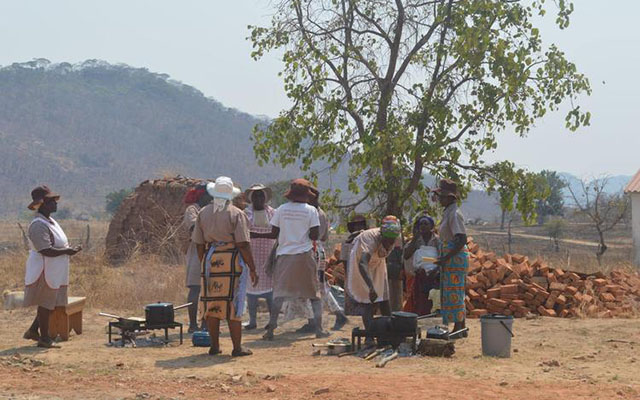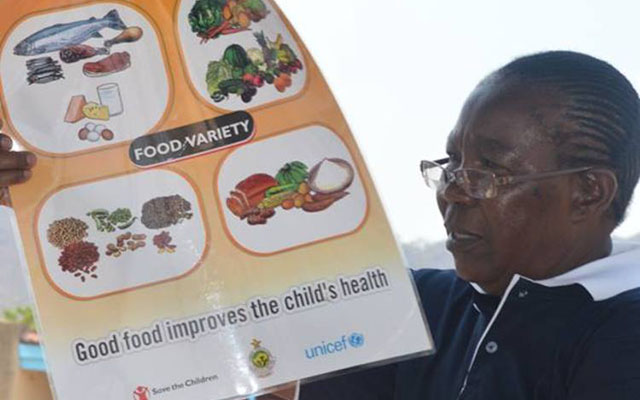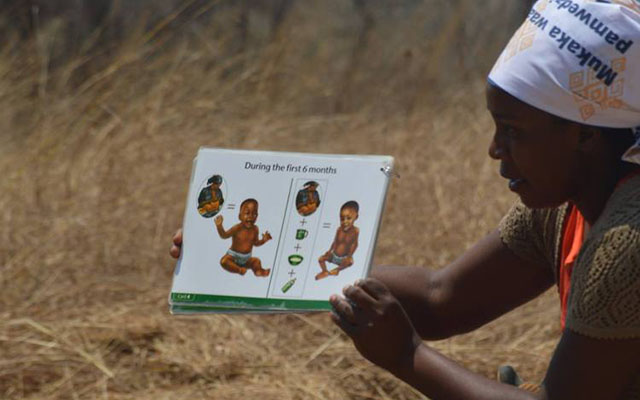Village health workers save lives

Charity Ruzvidzo Features Writer
Sanele Siziba (32) is a widow who fends for her family through selling vegetables and fruits from her garden in Shamva, about 90km north of the capital, Harare. Her vending business has enabled her to provide basic needs such as food, clothing and shelter for her family, following her husband’s death. To her, quantity and not quality is what matters about the intake of food.
But she has learnt the hard way about the gravity of lack of knowledge about staying healthy and eating nutritious food. In 2016, she noticed her two-year-old daughter Patricia was losing weight at an alarming pace. Her daughter had diarrhoea and quickly became frail and sickly. Patricia lost her glow and her eyes became sunken. Siziba got worried and suffered from a museum of disappointments. In a frantic attempt to keep her child alive, she took her child to a local church prophet who urged her keep “fasting and praying” for her child’s recovery. Months down the line Patricia’s situation got worse. Then came a Damascene moment. The life of her child was saved by a local village health worker.

Ministry of Health and Child Care deputy director for nutrition Mrs Ancircaria Chigumira speaks on the four-star diet
“After several visits to our church prophet my daughter was not getting better. It was the village health worker who observed my daughter and found she was suffering from malnutrition and referred me to the clinic,” she said. Siziba said the village health worker educated her on the causes and symptoms of malnutrition.
“I realised I was failing to provide a balanced diet to my child after the village health worker explained to me the four-star diet. I sell fruits and vegetables for a living and I never gave them to my family. I did not know it was important,” she said.
Patricia was introduced to food and water barely two months after her birth.
“I gave my daughter porridge a month after her birth. I would also give her water to drink and I did not practise exclusive breastfeeding. I had done the same with my first child and I did not face any challenges,” she said. At the clinic, Patricia was found to be malnourished. She was immediately placed on the four-star diet programme which comprises Vitamin A rich fruits and vegetables (mango, papaya, passion fruit, oranges, dark green leaves, carrots, yellow sweet potato and pumpkin).
The other fruits and vegetables included banana, pineapple, watermelon, tomatoes, avocado, eggplants and cabbages. Health experts say fruits and vegetables are vital to a balanced diet. They say they are a source of vitamins, minerals and dietary fibre which play an important role in preventing malnourishment. The diet should include animal source foods (meat, chicken, fish, liver and eggs) milk and milk products. Staples such as maize, wheat, rice, millet and sorghum; roots and tubers (cassava, potatoes). Legumes such as beans, lentils, peas and groundnuts should also be part of the diet. Siziba is amongst many people in rural communities who do not realise the importance of using their local farm produce such as vegetables and wild fruits to enhance their diet. She has since joined a women’s support group to boost her knowledge on how to stop malnutrition.
“Before treatment, Patricia suffered from low morale. She did not play with others and her appetite was very low,” she said. “Now, I have learnt a lot from nurses at our clinic. I have also joined a support group where we share experiences and advice on nutrition.” Recently, Save the Children, an international child rights NGO, organised a media tour in Shamva district to help highlight some of their programme activities in the district. The international NGO is working closely with the Government to empower rural women in the fight against hunger and malnutrition.
“The Government is playing its role in curbing malnutrition through its health institutions such as clinics where people can go for medication and treatment,” said Mrs Ancircaria Chigumira, a nutritionist in the Ministry of Health and Child Care.
“Communities must come on board and provide their families with a balanced diet through the use of their local farm produce. They must eat wild fruits and those from their own gardens too. They must not sell everything, but eat some to enable them to get vital vitamins.” Chigumira commended village health workers for educating women on the importance of exclusive breastfeeding.
“As we try to eradicate malnutrition it is very important for women to practice exclusive breastfeeding for the first six months after child birth as it reduces risks to diseases. I am happy to see that village health workers are already teaching about the benefits of breast feeding,” she said. Added Sophie Hamandishe, the spokeswoman for Save the Children (Zimbabwe): “We are teaching people through village health workers to be creative and innovative with their local farm produce.
“For instance, pumpkins can be served as pumpkin bread by adding flour and milk, instead of the normal routine where they are just boiled. Such creativity with food boosts children’s appetites.” According to the World Health Organisation, diseases caused by malnutrition include protein deficiency conditions such as marasmus, kwashiorkor, anaemia, night blindness, scurvy, rickets and goitre. Mostly, children and pregnant women suffer from these conditions. Lack of iron and vitamins in the food as well as hookworms and roundworms can also cause the diseases.
Scurvy is a disease caused by the deficiency of Vitamin C. People of any age can suffer from this disease. When a severe El Nino-induced drought bartered most parts of Zimbabwe in the 2015-2016 cropping season, the country experienced its worst malnutrition rates in 15 years, as nearly 33 000 children were in urgent need of treatment for severe malnutrition. The situation, however, improved after the country received better rains in the 2016/ 2017 farming season.
The UN Food and Agriculture Organisation estimates that 890 million people worldwide are food insecure with one in every three children chronically malnourished. According to the 2016 International Food Policy Research Institute Global Nutrition Report, malnutrition is on the rise in every country in the world and is a leading global driver of disease. The report shows that 44 percent of countries with data available (57 out of 129 countries) now experience very serious levels of both under-nutrition and adult overweight and obesity, and that, despite good progress in some countries, the world is off track to reduce and reverse this trend.
The researchers say malnutrition manifests itself in many different ways: as poor child growth and development, as individuals whose skin and bones are prone to infection, as those who carry too much weight or whose blood contains too much sugar, salt, fat or cholesterol, or those who are deficient in important vitamins or minerals. Further, the researchers say, malnutrition is responsible for nearly half of all deaths of children under age 5, and, together with poor diets, is the number one driver of the global burden of disease. At least 57 countries experience serious levels of both under-nutrition — including stunting and anaemia — and adult overweight and obesity, putting a massive strain on many already fragile health systems.
“One in three people suffer from some form of malnutrition,” said Lawrence Haddad, co-chair of the Global Nutrition Report’s Independent Expert Group and Senior Research Fellow at IPRI. We now live in a world where being malnourished is the new normal. It is a world that we must all claim as totally unacceptable.”









Comments